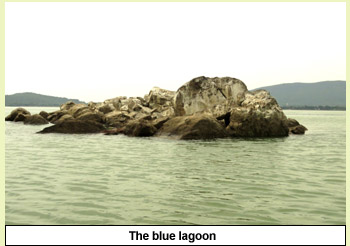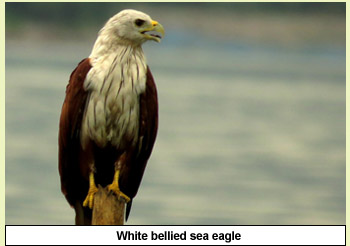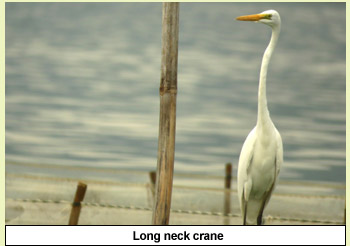| CHILIKA LAGOON THE THEATRE OF NATURE |
|
It is a place where dolphins, eagles, and fish along with humans co-habit in negotiated peace and unbroken harmony, writes SOMEN SENGUPTA.
 Till now at various small coastal villages of Odisha, a festival called Bali Yatra is celebrated on a big scale. People offer their homage to sea God and pray for safe passage of those who had left these shores many years ago for an unknown land named Bali. This Bali is today’s Indonesia where centuries ago for the sake of trade and commerce, people from this port used to grab the call of the sea.
Till now at various small coastal villages of Odisha, a festival called Bali Yatra is celebrated on a big scale. People offer their homage to sea God and pray for safe passage of those who had left these shores many years ago for an unknown land named Bali. This Bali is today’s Indonesia where centuries ago for the sake of trade and commerce, people from this port used to grab the call of the sea.
The port is long gone and so is Bali as a land of sea trade. Bali is now a sea retreat for rich people travelling to Indonesia, whereas the small coastal villages of Odisha have not changed much in terms of characteristics and natural beauty. The only change is that the sea shore where this port existed is no more and instead a huge lagoon dons the geography of region.
At the sea mouth of the Bay of Bengal on the coastal line of modern day Odisha, nature has created one of its best magnum opus. A huge water spread covering a surface area of 1,165 sq km and running more than 32 km on coastal line that touches three districts of Odisha viz Puri, Ganjam, and Khurda is an amazing natural beauty in every count. This lagoon is the second biggest in the world and home of one of the biggest congress of migratory birds flying down from Caspian Sea, Lake Baikal, Ara sea crossing over countries like Russia, Tibet, Mongolia and many other parts of the world. Needless to say, the treasure box of Chilika Lagoon has many more things to offer. Spotting a rare turtle on its sand bank or watching a couple of dolphins or a fish eagle are just a few more unforgettable things to mention.
 The coastal border of Odisha is one of the longest in India. Thanks to its proximity to sea, from time immemorial various sea ports dotted its sea shore and river confluence. According to a geological study, in the Pleistocene era, sea was extended on western shore and the entire area was under water. Then over the period, the coastline moved eastward creating a huge water body, which is now known as Chilika Lagoon. From December to June, salt water from the sea enters Chilika, while from July, fueled by monsoon water, 52 rivers and rivulets fill up the space with sweet water, thus completing a unique ecological process by nature. The coastal border of Odisha is one of the longest in India. Thanks to its proximity to sea, from time immemorial various sea ports dotted its sea shore and river confluence. According to a geological study, in the Pleistocene era, sea was extended on western shore and the entire area was under water. Then over the period, the coastline moved eastward creating a huge water body, which is now known as Chilika Lagoon. From December to June, salt water from the sea enters Chilika, while from July, fueled by monsoon water, 52 rivers and rivulets fill up the space with sweet water, thus completing a unique ecological process by nature.
If the science of geology has this to say, then mythology and local legend have much more to add. Chilika, which is the lifeline of all habitants of its islands and village on the shore, is loaded with legends. One legend has it that pirate king Raktabahu, with a plan to loot Puri temple, arrived here with a huge fleet of ship. Gauging his malicious intentions, the sea water moved backward, making anchoring impossible for the pirate. Out of anger, Raktabahu attacked the sea, which in turn washed him away with a part of it. That separated part of sea is today’s Chilika Lagoon.
Authentic history may not be very specific but has recorded many reference of a port which was here for many years. It was only for this port for which once upon a time Kalinga king was known as Lord of Sea. In the 10th century, in the ancient text Brahmanda Purana, this place was referred to as a point to connect Java, Malaya, Singhala and China, giving a correct relevance to Bali Yatra. In the travelogues of Greek traveller Ptolemy and Chinese traveller Fa-Hien and Xuan-zang, a port of Odisha named Chattragargh were mentioned. It is assumed that it was somewhere near Chilika. Fossil found here are as old as 3,500 years whereas the recent discovery of an iron anchor and a 7th century stone tablet from Kanas village near Chilika cements the fact that there was indeed a deep sea port here.
 Today, Chilika is one of the best natural resources of India and its importance in ecology and commerce is immense. It is a source of subsistence for both human and non-human habitants and a vital factor in Odisha’s biodiversity. It’s a highly productive ecosystem and its potential of tourism makes it a treasure gifted by God to India. Today, Chilika is one of the best natural resources of India and its importance in ecology and commerce is immense. It is a source of subsistence for both human and non-human habitants and a vital factor in Odisha’s biodiversity. It’s a highly productive ecosystem and its potential of tourism makes it a treasure gifted by God to India.
A bird eye view of the topographic map of Chilika clearly shows that its expansion is much more on east than west. In south, where the Bay of Bengal kisses the bank of the lake, the landscape is populated with several waterlines creating many sea mouths. These narrow waterlines connecting sea and the lake are the abode of famous Irraswaddy dolphins. This is their theatre of performance where they play and often jump from the water, offering treasured memories to visitors. The northern border line runs almost parallel to the railway track and National Highway 16, offering a breathtaking view of the huge water body with a rocky horizon.
No wonder that years ago while travelling on this railway track and overlooking the deep blue water of Chilika, legendary Oriya poet Gopabandhu Das was so spellbound that he mentioned that experience in detail in his writing. Like a national park, this lagoon also has several entry points and every point is distinctive and equally thrilling. The Rambha entry point takes one to the famous island mingled with legend and stories. Their names are equally amazing. One island is called Breakfast island, while another is called Honeymoon. If one enters the lake from Barkil and INS Chilika, the deep green water of the lake with rare birds will welcome you; you will have the maximum chance to see the dance of the dolphins if an entry is taken from Satpara near Puri.
 Every entry point has facility to see the lagoon in motor boats and high speed modern boats. A speed boat with a nature guide who knows the lake and its fauna are needed here. The boat glides in green and blue crystal clear water of the lagoon, touches banks of its islands and takes you near rare birds and dolphins. From every entry point, Chilika looks like a goldmine of watching migratory birds. The Zoological Survey of India has detected more than 800 species in and around Chilika, of which many are rare and endangered. The bird fauna of Chilika has no match with any other lake or lagoon of India. As many as 151 species from 26 families have been detected so far and it is increasing every passing year. Of these, 96 species are long-distant migrants and the rest are local. There are 13 species of eagles and 22 species of ducks here. Every entry point has facility to see the lagoon in motor boats and high speed modern boats. A speed boat with a nature guide who knows the lake and its fauna are needed here. The boat glides in green and blue crystal clear water of the lagoon, touches banks of its islands and takes you near rare birds and dolphins. From every entry point, Chilika looks like a goldmine of watching migratory birds. The Zoological Survey of India has detected more than 800 species in and around Chilika, of which many are rare and endangered. The bird fauna of Chilika has no match with any other lake or lagoon of India. As many as 151 species from 26 families have been detected so far and it is increasing every passing year. Of these, 96 species are long-distant migrants and the rest are local. There are 13 species of eagles and 22 species of ducks here.
Among rare birds, the golden plover arrives first in early September, while white bellied sea eagle, spoon billed sandpiper, cranes etc cover the entire lake. Chilika is a winter home for Central Asian waterfowl popularly known as flamingo. In winter, a large part of Chilika turns into a flamingo kingdom, and 75 per cent of these flamingoes park themselves near Nalabana island.
Like every other natural wonder, Chilika has its own dangers and threats. Massive encroachment and water pollution are some of the main worries. Overdose of tourism is also badly affecting its biodiversity balance. Overcoming all these, Chilika still stands tall in India’s natural wonder list. The Odisha Government also has formed several bodies to protect Chilika, the theatre of nature where dolphins, eagle and fish along with humans co-habit in negotiated peace and unbroken harmony.
This article was published in The Pioneer on 20th August 2017
Click here to view the original article
|



